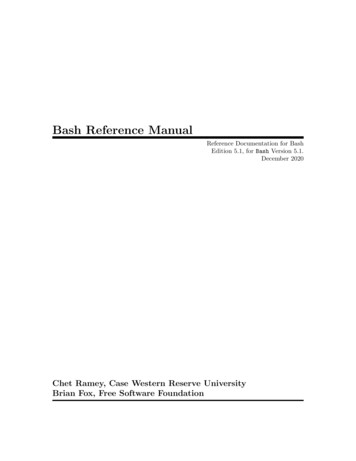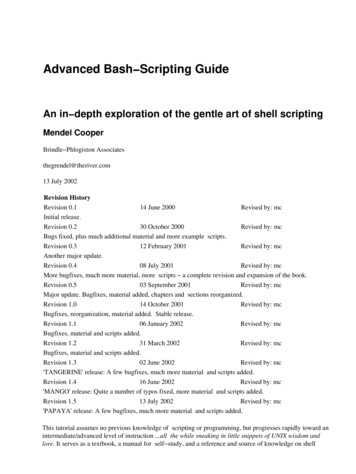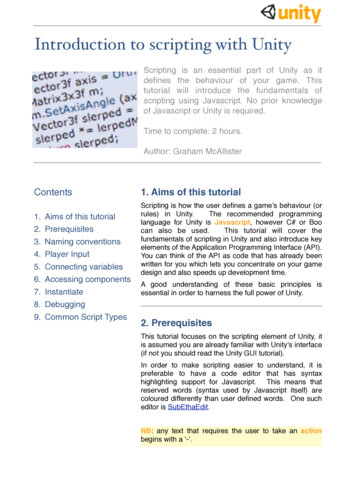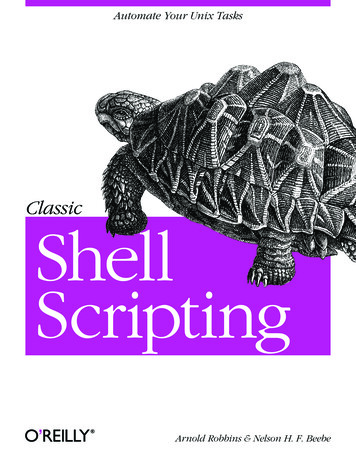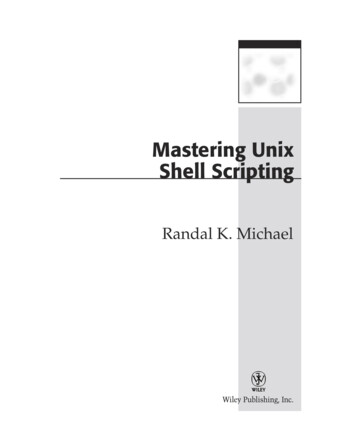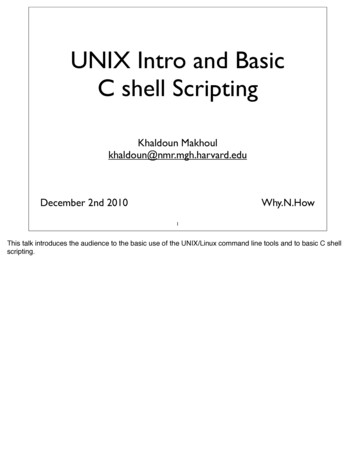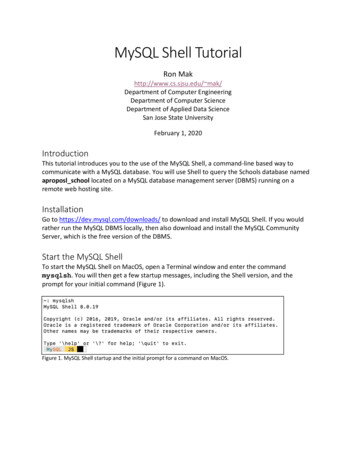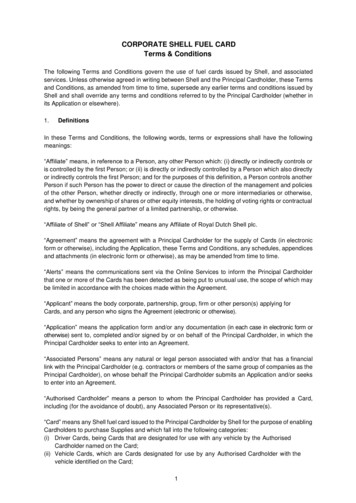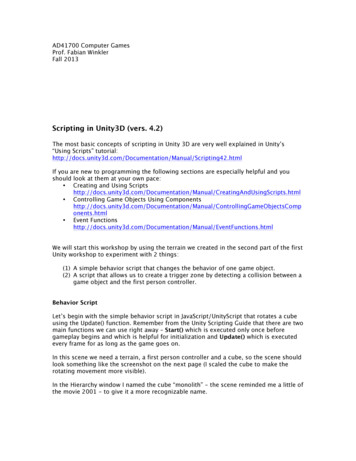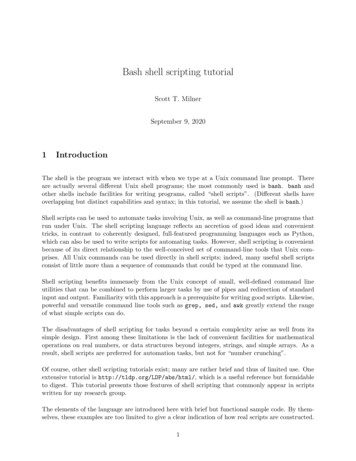
Transcription
Bash shell scripting tutorialScott T. MilnerSeptember 9, 20201IntroductionThe shell is the program we interact with when we type at a Unix command line prompt. Thereare actually several different Unix shell programs; the most commonly used is bash. bash andother shells include facilities for writing programs, called “shell scripts”. (Different shells haveoverlapping but distinct capabilities and syntax; in this tutorial, we assume the shell is bash.)Shell scripts can be used to automate tasks involving Unix, as well as command-line programs thatrun under Unix. The shell scripting language reflects an accretion of good ideas and convenienttricks, in contrast to coherently designed, full-featured programming languages such as Python,which can also be used to write scripts for automating tasks. However, shell scripting is convenientbecause of its direct relationship to the well-conceived set of command-line tools that Unix comprises. All Unix commands can be used directly in shell scripts; indeed, many useful shell scriptsconsist of little more than a sequence of commands that could be typed at the command line.Shell scripting benefits immensely from the Unix concept of small, well-defined command lineutilities that can be combined to perform larger tasks by use of pipes and redirection of standardinput and output. Familiarity with this approach is a prerequisite for writing good scripts. Likewise,powerful and versatile command line tools such as grep, sed, and awk greatly extend the rangeof what simple scripts can do.The disadvantages of shell scripting for tasks beyond a certain complexity arise as well from itssimple design. First among these limitations is the lack of convenient facilities for mathematicaloperations on real numbers, or data structures beyond integers, strings, and simple arrays. As aresult, shell scripts are preferred for automation tasks, but not for “number crunching”.Of course, other shell scripting tutorials exist; many are rather brief and thus of limited use. Oneextensive tutorial is http://tldp.org/LDP/abs/html/, which is a useful reference but formidableto digest. This tutorial presents those features of shell scripting that commonly appear in scriptswritten for my research group.The elements of the language are introduced here with brief but functional sample code. By themselves, these examples are too limited to give a clear indication of how real scripts are constructed.1
However, similar tasks and consequently similar techniques occur again and again in our scripts.Therefore, in the final part of this tutorial we present several complete scripts from real applications,annotated to highlight techniques we have found useful.22.1Language elementsVariablesThe traditional first program in any language prints out “Hello world”. Here is a shell script thatillustrates the use of variables:#!/bin/bash# to use a variable, just assign itsayIt "Hello"sayit sayIt" world"echo In bash scripts, # denotes a comment, and blank lines are allowed. The first line above is a commentto Unix, that the script should be executed with bash.In the script above, sayIt is first assigned the value “Hello”. Then, sayIt is assigned its old value,concatenated with “ world”. The value of a variable is accessed with .Shell variables need not be “declared” or “defined” first; just start using them. Shell variables donot have “types” (integer, real, string, etc.). More precisely, all shell variables are strings, but canbe interpreted and used as integers (discussed below).2.2ArgumentsValues can be passed to shell scripts by command-line arguments. Here is an example (script1.sh):#!/bin/bashecho Hello 1script1.sh Scott prints out “Hello Scott”. Up to 9 command-line arguments are accessed with 1 and so forth. # is the number of arguments passed.2
2.3StringsShell variables hold strings, which are assigned with (no space on either side):myString HelloTo assign a string containing spaces, enclose it in double quotes:myString "Hello world"To assign a string containing special characters that should not be “processed”, enclose it in singlequotes:myString ’echo 1’Strings are concatenated by placing them together:string1 "Hello "string2 "world!"bothStrings string1 string22.4Catching output from commandsShell scripts can contain any Unix command. Often, we want to save the output of the commandin a variable. This is done with backquotes (‘.‘), as follows:myFiles ‘ls‘myFiles now contains a string with all the filenames separated by spaces.An equivalent form is (.):myFiles (ls)As usual in Unix, the command inside ‘.‘ or (.) can be a sequence of commands separatedby semicolons, or a compound command involving pipes.3
2.5IntegersShell variables are fundamentally strings; however, shell scripting includes syntax that allows us totreat variables as integers.One way is to use let, which allows us to do math on variables that contain integers, usingoperations , -, *, /, ** (exponentiation), and parentheses:z 4let z ( z/2 4**2)* zwhich replaces z with 72. Note that division (/) here is integer, i.e., 5/2 2. Spaces are notpermitted around the , but can appear in the expression.A more convenient way to do math on integer-valued variables is with ((.)). Expressions insidedouble parentheses act as they would in C/C , with no need to use to obtain the value ofvariables. For example:((e 4*e 3**2))The right side evaluates without typing e, and the assignment is made. Operators like (increment) and % (mod) also work inside ((.)).2.6LoopsAutomation scripts typically involve looping. We may loop over values of some parameter, or a listof files to be processed. Or, we may continue a process while or until some condition is met.Shell scripting includes three constructs for looping: for, while, and until. All have a similarsyntax, with the body of the loop enclosed by do and done. while and until loops are controlledby a logical test (described below):while logical test do command1 command2 .donefor loops in shell scripts are different from those in C/C ; they iterate over a list of choices:4
for fruit in apple pear orangedoecho fruitdoneThe list of choices can be contained in a variable, or the output of a command:choiceList "apple pear orange"for fruit in choiceList.for file in ‘ls‘.To get a C-like for loop, use the shell command seq to generate a sequence to iterate over:for i in ‘seq 1 10‘.The general form of seq is seq start step end , where start and so forth are integers(or expressions that evaluate to integers), and step is optional (with default 1).2.7Logical testsTo compare two variables, we use a logical test (note the spaces between the brackets, variables,and ):[ string1 string2 ]To test for inequality, use ! .If the variables contain integers (see below), comparison operators -eq, -ne, -le, -ge, -lt, -gtcan be used.A more convenient form of logical test for integer-valued variables is to use ((.)). In the sameway as arithmetic operations on integers (see above), expressions inside ((.)) using the usualcomparison operators , , , , ! , && (and), and (or) will evaluate to “true” or“false”.Thus we can write logical tests in loops like5
while ((x**2 y**2 100)).and in if statements (see below) likeif ((x 2*y));then.2.8Control statementsIn addition to looping, shell scripting provides control statements to direct the execution. Thesimplest is the if-statement:if [ string1 string2 ];thenecho "equal"elseecho "not equal"fiThe logical test [.] takes the form described in the previous section, and must be followed by asemicolon. The then and else sections can contain multiple commands. The else clause may beomitted.An if-statement with an “else-if” secondary test can be written asif [ string1 string2 ];thenecho "equal"elif [ string1 "default" ];thenecho "default"fiIn the above example, for simplicity the else cases have been omitted from the primary andsecondary tests.6
2.9Random choicesThe shell provides a facility for generating 16-bit random integers (ranging from 0 to 215 -1 32767).Each time the shell variable RANDOM is evaluated, a different pseudorandom number is obtained.These can be used to make random choices among a relatively small number of alternatives, inconjunction with the mod (%) operator and integer arithmetic.The mod operator computes the remainder of an integer divided by the modulus: echo ((5 % 2))gives 1, while echo ((-5 % 2)) gives -1.For example, to choose between two possibilities with equal probability,if (( RANDOM % 2 0));.2.10Case statementsMultiway branching can be performed with a case statement. The comparison is different fromif; here, the argument is matched to a succession of “patterns”, each of which is terminated witha closing parenthesis ):case percent in[1-4]*)echo "less than 50 percent" ;;[5-8]*)echo "less than 90 percent" ;;*)echo "90 percent or greater" ;;esacNote the double semicolon terminating each command (which as usual can be multiple commandson multiple lines).The patterns to be matched use the same syntax as in other Unix operations (commonly used invi, grep, ls, rm, and the like). For completeness, patterns are described briefly in the nextsection.2.11PatternsPatterns (or “regular expressions”) are used by several Unix command-line programs and utilities.File management programs like ls, cp, mv, rm, and tar use patterns to select files to operate on.7
The Unix utility grep selects lines from its input (stdin) that match a pattern, and prints thoselines to stdout. The Unix visual editor vi, and the stream editor sed use patterns in its searchingand substitution.Patterns are strings, possibly containing special characters, which match part or all of other strings.A simple example is ls *.sh, which lists all files with names ending in .sh (i.e., all shell scripts,if we adhere to that naming convention). Because effective use of patterns extends the capabilitiesof Unix tools like grep and sed that frequently appear in scripts, we include here a table of thespecial characters used in patterns and their meanings.Table 1: Special characters used in regular expressions and their meanings.pattern .*[.][a-k][2-5][ .]\ .\ \(.\)\1, \2, .matchesbeginning of stringend of stringany single characterzero or more repeats of previous characterany one of the enclosed charactersany one of the range of charactersany one of the range of digitsany character not in . . .pattern . . . only matches a wordsaves pattern matched by . . .the first, second, . . . pattern savedPattern matching is useful in many contexts, but can be tricky — it is often a good idea to testpatterns in a safe situation before relying on them where errors can do damage (as with rm).2.12FunctionsIn longer scripts it is often convenient to define functions, to perform a well-define subtask that iscalled upon multiple times.Command-line arguments can be passed to functions in the same way as for scripts generally, withvariables 1, 2 and so forth. Variables declared with local are protected from meddling by themain program. Shell script functions do not return values, so functions must communicate withthe calling program through global variables.The syntax for defining a function is simple:function newFcn {.}8
in which . are one or more commands.2.13Return statusFunctions can return a value that indicates the status of the function call; by convention, 0 indicatessuccess and nonzero values indicate some error. For a user-defined function, the return value is setwith return value .All built-in shell functions return such values. The return value of the most recently called functioncan be accessed with ?.Return values of functions can be used as logical tests. For example:while read nextLinedoecho nextLinedonereads successive lines and echoes them until the file is empty, at which point read returns a nonzerovalue, and the while loop ends.Another way to use return status of functions and commands, is together with the operators &&(logical and) and (logical or). The syntax cmd1 && cmd2 executes the second command only if the first one succeeds (i.e., returns status 0). This constructcan be used to run a “check” (for the existence of a file) before executing a command.Similarly, cmd1 cmd2 executes the second command only if the first one fails (i.e., returns status 1). This construct canbe used to run a “fallback” command if the first one fails.2.14Writing to filesOutput to files can be written using Unix command line tools, including echo, cat, and printf.echo writes strings; cat concatenates one or more files; and printf prints one or more variables ina specified format, similar to print statements in C/C .9
For example,echo "var1 equals" var1writes the concatenated string consisting of the text strings and variable.printf writes one or more variables using a C-style format string, which provides a convenient wayof controlling the output format:printf "%5s %10.5f%12.4g%5i\n" s1 f1 f2 i1writes string s1 in 5 spaces, followed by floating-point variable f1 in 10 spaces with 5 decimalplaces, f2 in scientific notation in 12 spaces with 4 decimal places, and integer i1 in five spaces.Finally, cat concatenates a list of files into a single file directed to stdout, as in:cat file1 file2 file32.15Output redirectionAll three utilities echo, cat, and print write to stdout (standard output). However, this outputcan be redirected to write or append to a file with or . If a script is invoked with redirection,as inmyScript.sh myFile.outall commands in the script that write to stdout are redirected to myFile.out. This is convenientif the script only produces one output file, since redirection can be used to save the file with anydesired name.Sometimes, a script writes more than one output file. Then, it is convenient to redirect output ofcommands within the script. This is done with the same and syntax. For example,cat file1 file2 file3writes file3 (overwriting if it exists); whereas,cat file1 file2 file3appends to file3 if it exists (and creates it otherwise).10
2.16“here” documentsSometimes, it is convenient to store a small file within a script, for use with a utility like cat thatrequires a file as input. This can be accomplished with a “here” document:cat EOFfirst linesecond linethird lineEOFIn this example, cat will write the file (consisting of three lines) to stdout. Here documents can becombined with output redirection, by replacing the first line withcat myFile.out EOFHere documents can be used with any command that requires a file as input, as an alternative tomaintaining a separate “database file” that is redirected to input, like this:cat database.in myFile.out2.17Reading inputThe Unix utility read is used to get input from files. By default, read takes input from stdin. Toread a single line of text:read newLineTo read multiple arguments (separated by spaces) from a single line of text:read arg1 arg2 arg3Often, we want to read all the lines in a file, processing each line in some way until the file is empty.This can be done with a while loop:while read newLinedoecho newLinedone11
The read command returns status 0 (“true”) if a line is read, and nonzero (”false”) if the end offile is reached. This serves as a logical test to control the while loop. If input is read from stdin(the keyboard), ctrl-D acts as an end-of-file to terminate input.2.18Reading from a stringSometimes it is convenient to read from a string; for example, we can use read to parse a stringinto arguments. This may be regarded as a form of input redirection, or a variation on a “here”document.To read from a string:read arg1 arg2 arg3 mystring2.19Input redirectionIf a script is invoked with input redirection, as inmyScript.sh myFile.inall read commands in the script that have not been redirected then take input from myFile.in.This is convenient if the script only reads from one file, which we specify when we invoke the script.Sometimes, a script reads from more than one file. Then, we can also invoke input redirectionwithin the script. For example:while read newLinedoecho newLinedone myFile.txtNote how the redirection follows the entire while loop construct; all reads inside the while loopcome from myFile.txt.However, if we want to read two successive lines from a file, the obvious coderead line1 myFile.txtread line2 myFile.txt12
does not work as intended; both reads take the first line from myFile.txt. To achieve the desiredresult requires a different approach, described in the next section.2.20Open a fileIn languages like C/C or Python, facilities exist for “opening” a file, which provides a file“pointer” that advances with each successive read. When reading is done, the file must be “closed”.The following syntax accomplishes this in a shell script:# open the fileexec 3 inFile# read from the file (first line)read 0 &3 arg1 arg2# read again (second line)read 0 &3 arg3 arg4# close the fileexec 3 &-Here 3 is a file “channel”, where 0 is standard input (stdin), 1 is standard output (stdout), and 2 isstandard error (stderr). If more than one file must be opened at once, channels 4, 5, and so forthcan be used.2.21ArraysFull-featured programming languages offer data structures more complex than a single variable.The simplest of these are arrays. The shell provides array variables, which are lists of simplevariables that can be accessed by index and iterated over.An array can be created by reading a list of arguments separated by spaces from a single line (theflag -a directs read to create an array):read -a myArrayArrays can also be assigned by listing the elements within parentheses:myArray ("apple" "pear" "orange" otherFruit)Elements of the array can be accessed by index, as13
firstElement {myArray[0]}(The array index starts at 0.) The length of the array is accessible with the same syntax as thelength of a string: {#myArray[@]}The entire array can be accessed as a single string (with elements separated by spaces): {myArray[@]}Arrays can be iterated over with a for loop:for i in {myArray[@]}do.done2.22SubstringsOften we need to take part of a string. Substrings can be accessed as follows:myString "abcdefg"newString {myString:2:3}newString then equals bcd, i.e., a substring starting at character 2, of length 3.If the 2 above is omitted, the substring starts at 1; thus {myString::3} equals abc.Likewise, if the :3 is omitted, the substring goes to the end; thus {myString:2} equals bcdefg.Characters can be removed from the end of a string with {myString% pattern }where pattern is a string possibly including “wildcard” characters. For example, ? matches anysingle character, so that14
{myString%?}drops the last three characters from myString.Finally, the length of a string is given by {#myString}2.23Floating point mathFloating point math operations in shell scripting are limited and awkward, which constrains its usein programs that crunch numbers. However, many shell scripts require only a few floating-pointcalculations. For this purpose, the Unix utility bc (basic calculator) can be used.bc implements a rather modest calculator, with arithmetic operations , -, *, /. When invokedwith option -l, a very few scientific functions are available (s(x) sine, c(x) cosine, a(x) arctan, l(x) natural log, e(x) exponential, sqrt(x) square root).bc is normally an interactive program; launched from the command line, it responds to typed input.To use bc in a script, input can be supplied from echo via a pipe:echo "c(3.14159/2)" bc -lThe output can be saved in a variable using backquotes ‘.‘:myResult ‘echo "c(3.14159/2)" bc -l‘Variables can be included in the input expression:echo " var1* var2" bc -lThe number of output digits can be controlled with the command scale n . This only works ifthe expression includes division, which can be worked around by dividing by 1 somewhere.echo "scale 3;3.14*7/2 1" bc -l15
2.24Automating interactive programsUsing echo to supply what would have been typed input to bc is an example of a general approachto make interactive programs “scriptable”.Another way to do this is with input redirection from a string, which we encountered with read inconstructions like read arg1 arg2 inputLine.The same syntax can be used with bc, and any other program or utility that expects typed inputfrom stdin:myResult ‘bc -l "c(3.14159/2)"‘2.25Auxiliary programsUnix provides a number of very powerful utility programs, chief among them grep, sed, and awk,which can be used to great advantage in shell scripts.grep (Globally search for Regular Expression and Print) searches for patterns (“regular expressions”) on each line of its input, and writes the lines matching the pattern to stdout. The basicformat isgrep pattern file in which pattern is any string, possibly containing one or more regular expressions (see “Patterns” above). If file is not specified, grep takes its input from stdin.awk (named for its co-creators Aho, Weinberger, Kernihan) acts on each line of its input, splittingit into fields, doing simple calculations, and printing output.Finally, sed (Stream EDitor) acts with editing commands on each line of its input, producing astream of output lines. An important use of sed is to produce a sequence of files from a common“template file”, in which only a few parameters are replaced by some iterated value. A typical useof sed looks like this:sed "s/ANG1/ myAng1/; s/ANG2/ myAng2/" infile outfileHere all occurrences in infile of the “template parameter” ANG1 are replaced by the value of thevariable myAng1, and likewise for ANG2 and myAng2. The commands within quotes are standardvi substitution commands.16
3Example scriptsIn this section, we present several scripts that automate various tasks arising in my research.Although the particular applications pertain to my group, the categories of tasks they representand the scripting techniques they employ are relevant to any computational researcher.The scripts fall roughly into three categories:1. extracting data from output or log files of computational programs;2. automating compute jobs, submitted to PBS or other queue systems;3. constructing long and repetitive input files.17
3.11234567891011121314151617181920Extracting results from files. SCF Done: E(RB3LYP) . Alpha occ. eigenvaluesAlpha occ. eigenvaluesAlpha occ. eigenvaluesAlpha occ. eigenvaluesAlpha occ. eigenvaluesAlpha virt. eigenvaluesAlpha virt. eigenvaluesAlpha virt. eigenvaluesAlpha virt. eigenvaluesAlpha virt. eigenvaluesAlpha virt. eigenvaluesAlpha virt. eigenvaluesAlpha virt. eigenvaluesAlpha virt. eigenvaluesAlpha virt. eigenvaluesAlpha virt. eigenvalues.-552.938806292-----------------A.U. after10 cycles -88.90122 -10.22991 -10.22991 -10.21007 -10.20983 -7.97827 -5.94170 -5.93770 -5.93284 -0.87872 -0.73873 -0.73631 -0.57462 -0.56304 -0.52033 -0.43087 -0.40782 -0.38726 -0.37642 -0.34632 -0.25864 -0.24890 -0.029660.006060.011370.031290.03259 0.034740.040110.061370.061960.06943 0.091100.091790.102010.105450.11620 0.140210.146410.152300.153330.16807 0.168350.201410.203940.212030.21387 0.253770.265550.274700.314530.36792 0.459750.495340.511520.539560.58259 0.617090.678870.695720.697990.70991 0.731490.740130.779020.879530.92346 0.973860.987601.005611.077321.08930 1.176291.191351.229121.328971.42423 Figure 1: Excerpt from Gaussian log file.A common task for scripts is to extract values of interest from the log file of some computationalprogram. Such log files are typically long text files, full of comments and information. Shell textprocessing commands are helpful in finding the relevant lines and extracting the desired fields fromthose lines.Above is an example of log file output from the quantum chemistry program Gaussian, wherethe energy levels are printed sequentially from most to least strongly bound. The occupied andunoccupied orbitals are denoted Alpha occ. and Alpha virt. respectively. The HOMO (highestoccupied molecular orbital) is thus the last Alpha occ. entry, and the LUMO (lowest unoccupiedmolecular orbital) is the first Alpha virt. entry. Separately, the ground state energy is reportedon the line beginning SCF Done:.The script below (analyz.sh) extracts the HOMO, LUMO, and ground state energy from a list offiles read from stdin ((CHANGE THIS IN SCRIPT)), and computes the difference of these valuesfrom those in a reference calculation. (The purpose here is to analyze how the HOMO, LUMO,and ground state energy change with molecular distortion corresponding to different amplitudes ofa normal mode. The set of Gaussian jobs with different imposed normal mode amplitudes weregenerated manually from a reference job in which normal modes were computed, by examining thenormal mode, setting the amplitude manually, and saving a new compute job.)The script uses command-line tools grep, head, and tail to extract the lines containing the groundstate energy, HOMO, and LUMO ((FIX THIS — no need to use head and tail both on each line.And put SCF Done first.)). Briefly, grep searches stdin for all lines containing a given pattern.Usually, the desired line in a file can be uniquely specified by a well-chosen grep (as here for theground state). But for the HOMO and LUMO, the obvious grep (of “Alpha occ” and “Alpha virt”)finds multiple lines. So we use head -n 1 and Alpha occ. to print the first and last lines of stdin,to obtain the relevant line in each case. The commands are strung together with pipes ), whichdirects the output (stdout) of one command into the input (stdin) of the next.18
The relevant field is extracted and printed with awk, which is a command-line tool useful for thispurpose. The same thing could be accomplished using read -a to fill an array args with thesuccessive fields in the extracted line, and extracting the desired field by indexing the array, asindicated in the comments.The difference between the extracted and reference values are computed using bc, and printed tostdout in a desired format with ash # awk is convenient here to select fields; this could also be done as # read -a args grep "Alpha occ" thiophene.log tail -1 # eh0 {args[5]} eg0 grep "SCF Done" thiophene.log awk '{ print 5 }' eh0 grep "Alpha occ" thiophene.log tail -n 1 awk '{ print 6 }' el0 grep "Alpha virt" thiophene.log head -n 1 awk '{ print 5 }' printf "%12s%12s%12s\n" "Delta E H" "Delta E L" "Delta E g" while read file do eg grep "SCF Done" file awk '{ print 5 }' eh grep "Alpha occ" file tail -n 1 awk '{ print 6 }' el grep "Alpha virt" file head -n 1 awk '{ print 5 }' deh echo " eh - eh0" bc del echo " el - el0" bc deg echo " eg - eg0" bc printf "%12.5f%12.5f%12.5f\n" deh del deg done Figure 2: analyz.sh, a script to extract results from a Gaussian log file.The script is used with input redirection, with a list of files like mode11.txt below. (The namesindicate the mode amplitude: “m4” equals minus 0.4Å, and so forth.)12345678910mode11m4.log mode11m3.log mode11m2.log mode11m1.log thiophene.log mode11p1.log mode11p2.log mode11p3.log mode11p4.log Figure 3: Input file list for analyz.sh.19
2930313233343536373839404142Batch job#PBS -A open #PBS -l nodes 1:ppn 8 #PBS -l walltime 8:00:00 #PBS -l pmem 1gb #PBS -m aeb #PBS -M stm9@psu.edu #PBS -j oe # load group local copy of Gromacs source M/single/bin/GMXRC # cd to working directory, define directories cd PBS O WORKDIR MDP PBS O WORKDIR/MDP SYSTEM PBS O WORKDIR/System # energy minimization mkdir EM cd EM gmx grompp -f MDP/em.mdp -c SYSTEM/system.gro -p SYSTEM/topol.top -o em.tpr -maxwarn 20 gmx mdrun -nt 8 -deffnm em # NVT equilibration cd ./ mkdir NVT cd NVT gmx grompp -f MDP/nvt.mdp -c ./EM/em.gro -p SYSTEM/topol.top -o nvt.tpr -maxwarn 20 gmx mdrun -nt 8 -deffnm nvt # NPT equilibration cd ./ mkdir NPT cd NPT gmx grompp -f MDP/npt.mdp -c ./NVT/nvt.gro -p SYSTEM/topol.top -o npt.tpr -maxwarn 20 gmx mdrun -nt 8 -deffnm npt # MD production run cd ./ mkdir MD cd MD gmx grompp -f MDP/md.mdp -c ./NPT/npt.gro -p SYSTEM/topol.top -o md.tpr -maxwarn 20 gmx mdrun -nt 8 -deffnm mdFigure 4: job.sh, a typical Gromacs batch job script.A very common use of shell scripts is for submitting batch jobs to PBS (Portable Batch System).Batch scripts are ordinary shell scripts, plus a set of comments at the beginning that contain directives to PBS. These directives request resources (nodes, cores, memory, and time), direct the job toa particular queue or allocation, request that mail be sent when the job starts or ends, and so forth.For details on PBS directives, see df.The script below (job.sh) is a typical Gromacs batch job, with no control statements or otherautomation features. It consists essentially of a set of commands that could have been enteredsequentially at the command line.The only difference is the line cd PBS O WORKDIR, which navigates to the folder from which thejob was launched. The shell variable PBS O WORKDIR (Original WORKing DIRectory) is the full20
path to the directory from which the command qsub job.sh was executed. For convenience,variables MDP and SYSTEM are defined as paths to subfolders of PBS O WORKDIR.21
29 3031323334353637Morphing simulation scripts#!/bin/bash #PBS -A open #PBS -l nodes 1:ppn 8 #PBS -l walltime 24:00:00 #PBS -l pmem 1gb #PBS -j oe source M/single/bin/GMXRC echo PBS O WORKDIR cd PBS O WORKDIR MDP PBS O WORKDIR/MDP SYSTEM PBS O WORKDIR/System TEMP /gpfs/scratch/stm9/vanish mkdir TEMP INIT
Bash shell scripting tutorial Scott T. Milner September 9, 2020 1 Introduction The shell is the program we interact with when we type at a Unix command line prompt. There are actually several di erent Unix shell programs; the most commonly used is bash. bash and other shells include facilities for writing programs, called \shell scripts".
